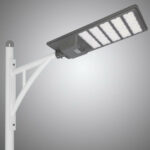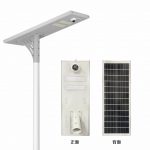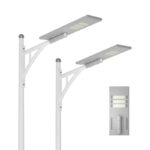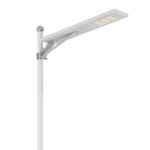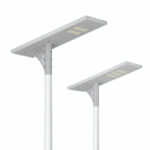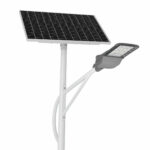Jinja City in Uganda is the latest city in sub-Saharan Africa to embrace the cost savings and environmental benefits of solar-powered street illumination.

Marianne Dhenin
May 4, 2021 at 12:00 PM GMT+8
In 2016, on the northern shore of Lake Victoria, Jinja City sat in darkness. The city, the second-largest in Uganda, had run up an overdue power bill of 1.3 billion Ugandan shillings ($3.5 million), so Umeme, the nation’s largest energy distributor, disconnected the city’s street lights.
Even before Umeme cut the power, most roads in this city of 870,000 near the source of the White Nile lacked illumination: Only the colonial-era center of town was equipped with street lights, and many of these had begun to sputter out due to age and poor maintenance. Districts that had grown as unplanned areas on the outskirts before being incorporated into the city had never been lit at all. “The area in the city that is planned is quite small,” says Kennedy Kibedi, a social media marketing specialist who works in tourism in Jinja City. “On the fringes of the city, in the suburbs, there’s a lot of informal development.”
That pattern holds true for many of Africa’s largest cities. As places like Nairobi, Lagos, and Kampala have grown, they’ve absorbed informal settlements that aren’t connected to national power grids. As a result, street lighting is scarce, scattered and unreliable, and the costs for installing conventional grid-based lighting are high.
So Jinja City administrators looked to neighboring Kampala, the nation’s capital and its largest city, for an alternative solution: solar-powered street lights, powered not by the grid but by photovoltaic panels and batteries that are either attached to each light pole or housed at a mini power station to support a group of lights.

The Kampala Capital City Authority began revamping that city’s street lighting with solar-powered equipment in 2014, when just 115 kilometers of 1,200 kilometers of roads in Kampala had street lights, and only a fraction of those were operational. By 2016, when Jinja City was grappling with its power cut, the success of Kampala’s program was already apparent. Reports published that year show that the new street lights had reduced energy usage and costs, decreased traffic fatalities and accidents, and helped foster a more vibrant night economy in the capital city.
Following suit, Jinja City began installing solar-powered lighting in 2016, installing more than 100 over three years. Like in Kampala, in Jinja City, the economic and social benefits were immediate. With just its first projects, which lit a 2.5 kilometer stretch of Main Street and some priority streets near a hospital and market square, the city saved more than 55 million Ugandan shillings ($15,200) in installation costs compared to conventional street lighting installation, and the cost savings have continued to grow. The new equipment reduced installation costs by at least 25% and maintenance costs by as much as 60%, city officials say.
“The most important [thing] is the fact that now we are able to save a lot of money that would have gone into paying bills for electricity,” says Bernard Mbayo, a Jinja City councilor. The city also raises funds from selling advertising space on the new light poles. The increase in revenue has allowed Jinja City’s administrators to concentrate on other priorities, such as garbage collection and upgrading public parks, says Mbayo.
Businesses on newly lit streets have also seen increases in revenue as they can operate for longer hours after sunset. In an email, a spokesperson for the Anmol Restaurant and Bar on Main Street says that “street lighting has changed our business.” Locals and visitors feel more secure about frequenting restaurants or shops after dark, and employees feel safer walking home.
Kibedi says he believes the new street lighting had boosted Jinja City’s tourism sector, too. Uganda closed its borders at the beginning of the pandemic, but in pre-Covid times Jinja City drew international visitors to the “adventure capital of East Africa” for outdoor activities like boating on Lake Victoria or bungee jumping over the Nile. Other tourists come to explore the city’s colonial architecture or attend annual music festivals like the Nyege Nyege Festival, which features East African electronica artists and draws thousands of fans to the area annually.
“We have seen the numbers [of tourists] grow tremendously,” says Kibedi, “and I believe street lighting has something to do with that because you can now find tourists walking in the streets at night. They don’t feel threatened and I think this has a big impact on tourism.”

The rapid adoption of solar street lighting in cities poorly served by conventional power generation is an example of the technological “leapfrogging” that sub-Saharan Africa is known for. But Uganda’s shift to solar-powered street lights has not been without challenges. While costs are lower than for conventional lighting, the startup costs still strain the struggling city budgets. The potential for wider adoption in Jinja City is also circumscribed by the local planning department’s limited technical capacities. Financial and technical support from a World Bank program called Uganda Support to Municipal Infrastructure Development, or USMID, is helping address both issues: The program has committed a total of $510 million to support infrastructure development in places like Jinja City until 2023. Thanks to technical support from USMID, Jinja City now has a master plan, which will allow for the continued rollout of solar-powered street lights citywide.
Mbayo says that the Ugandan Central Government has recognized the potential for continued rollout in Jinja City and recently allocated funds to light an additional 54 kilometers of streets — a significant portion of the roughly 380 total kilometers of roadway in the city. Now, the role of the city council is to identify which streets will be lit next. Mbayo hopes that the funding will allow the city to complete lighting the central business district.
“We are also working towards ensuring that our city’s financially self-sustaining,” says Mbayo. The goal is that after USMID support has been withdrawn in a couple of years, Jinja City will continue to develop according to its new master plan.
Mbayo says the lesson for other cities is that solar-powered street lighting can be the first step on a longer path in sustainable urban development: He’s shared the stories of Jinja City’s success and their lessons learned with administrators in other African cities, including Freetown, South Africa, and Dakar, Senegal. The Senegalese government began its own project to install 50,000 solar-powered street lights throughout the country in 2019; the work, done by French company Fonroche Eclairage, was slowed by the pandemic but is now about halfway complete.
The success of these efforts could have broad effects on the region: Researchers suggest that if solar-powered street lighting continues to be installed in sub-Saharan Africa, it could add tens of thousands of working hours daily by extending the workday past sunset while slashing electricity consumption from street lighting by 40%. Solar lighting could generate between 96 and 160 gigawatts of renewable energy across the subcontinent — more than doubling the current rate of energy generation. “We have no doubt what we’re doing here is impacting people’s lives,” says Mbayo, “and we want this to go to other cities.”
